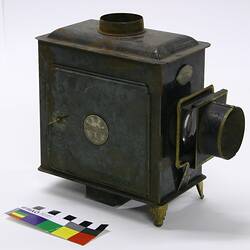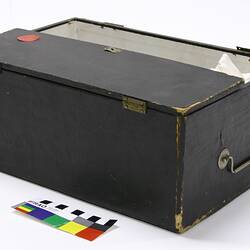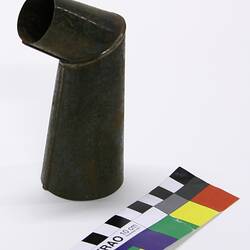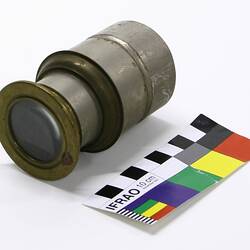Summary
Children's toy magic lantern projector set, designed for domestic use with miniature glass slides. 'Standard E.P.' model manufactured by Ernest Plank, Bavaria, Germany, circa 1908. Imported & distributed by A.W. Gamage Ltd., Holborn, London.
The Ernst Plank Company was situated in the German town of Nuremberg, with the business first listed in the Commercial Register of Nuremberg as 'Ernst Plank, Fabrik Optischer und Mechanischer Waren' in 1866. Apart from miniature magic lanterns, the firm made a variety of mechanical toys, including operable stationary steam engines, trains, steamboats and sewing machines produced from pressed tin plate. By the late 19th century Nuremberg had become the largest toy making centre in Europe, with at least eight major manufacturers based there, of which Ernst Plank was the second largest after 'Gebrüder Bing'. Plank's toys were notable for their quality, often being ornate in design and more finely finished that other manufacturers. The factory survived the First World War, but production declined in the 1920s and was sold to the brothers Hans and Fritz Schaller in 1930, who specialised in the manufacture of toy cinematographic projectors & home movie equipment. After World War II, the company became Noris Projecktor GmbH, remaining in business until 1965. Almost all the magic lanterns from Plank are marked with the initials 'E.P.' or the firm's famous trade mark which features a winged wheel above the initials 'E.P.'.
When new this lantern set came in a box complete with the projector, a small spirit lamp, various assessories and an assortment of slides. It was imported by A.W. Gamage, a department store in Holborn, London. Begun in modest watch repair shop in 1878, the store grew into a vast emporium covering over two acres by 1904, with an extensive toy department that included magic lanterns and lantern slides. Many of the magic lanterns were supplied by manufacturers in Germany.
This toy magic lantern set is part of the Francis Collection of pre-cinematic apparatus and ephemera, acquired by the Australian and Victorian Governments in 1975. David Francis was the curator of the National Film and Sound Archive of the British Film Institute as well as being a co-founder of the Museum of the Moving Image in London, which was operational between 1988 and 1999.
Physical Description
Object is an upright rectangular japanned metal box trimmed with three ornate brass feet (a fourth is missing). A door on the left side of the lantern gives access to the illumination chamber. The chimney has an elbow which stops light from escaping from the chamber. Vents along the lower margin of the back and underneath the lantern allow for heat dispersal. Shutter on the front with facility for slide carrier.
More Information
-
Collection Names
-
Collecting Areas
-
Acquisition Information
Loan & Subsequent Donation from Australian Film Institute (AFI), Mr David Francis, by Nov 1990
-
Manufacturer
Lantern Slide & Toy Producers, Ernst Plank, Nuremberg, Bavaria, Germany, 1866-1930
-
Retailer
A.W. Gamage, Holborn, London, England, Great Britain, 1878-1930
-
Collector
-
Inscriptions
Circular plaque on left side: 'STANDARD E.P.' Fish eye plaque on front: 'A.W. GAMAGE LTD. / HOLBORN / LONDON. / MADE IN BAVARIA'
-
Classification
-
Category
-
Discipline
-
Type of item
-
Overall Dimensions
207 mm (Length), 100 mm (Width), 190 mm (Height)
Projector
-
References
de Luikerwaal, Magic Lanterns manufactured by Ernst Plank, [Link 1] accessed 1/7/2011. McCann, B., 'London's Lost Department Stores: Gamages', in The Story of London, 2008, [Link 2] accessed 13/8/2008.
[Book] Robinson, David, et al. 2001. Encyclopaedia of the Magic Lantern., 2001, 121, 122, 235 Pages
-
Keywords





